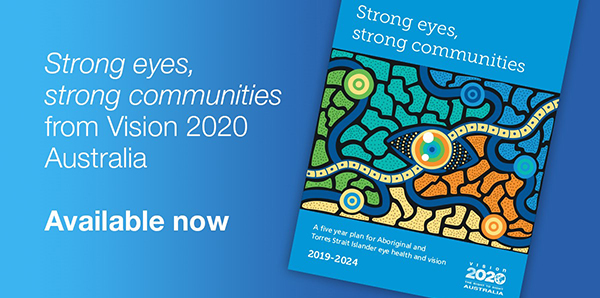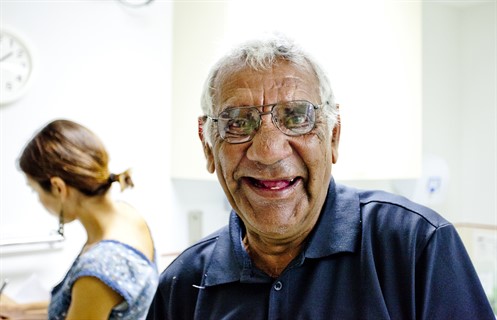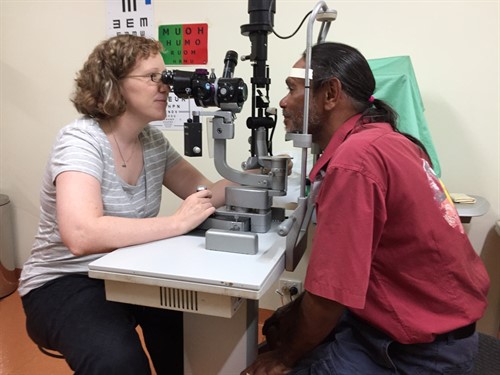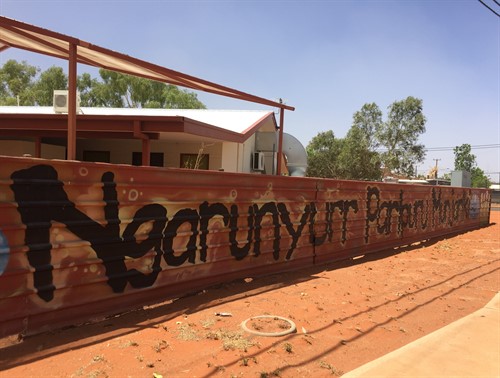1:30min

By Sarah Davies
Optometry Australia Policy and Advocacy Manager
Members of Vision 2020 Australia, the peak body for the eye sector, are calling for implementation of Strong Eyes, Strong Communities – a five-year plan setting out 24 recommendations to close the gap in vision with Aboriginal and Torres Strait Islander people.
Strong Eyes, Strong Communities calls for an active partnership between the eye health sector, federal, state and territory governments, Aboriginal and Torres Strait Islander people and their organisations to take action in four areas:
- Enhance service delivery by expanding current eye health and vision care services (including implementation of nationally consistent subsidised spectacles schemes,) increasing outreach funding flexibility and developing new Aboriginal Community Controlled Health Organisation (ACCHO) led service models.
- Strengthen regional partnerships and local supports, as these will continue to be core to making local and regional systems work as well as they can for Aboriginal and Torres Strait Islander people.
- Embed eye health in ACCHOs and other primary care organisations, through a combination of workforce, system and awareness-raising activities.
- Eliminate trachoma, with a sustained focus on full implementation of the SAFE strategy, including targetted efforts to enhance environmental health and embed ongoing screening in primary health care.
Vision 2020 Australia is also calling for a 2020 National Eye Health Survey to monitor progress and ensure that the investments made positively impact on the eye health and vision of Aboriginal and Torres Strait Islander people.

Victor looks pleased with his new glasses. Photo, courtesy Brien Holden Vision Institute Foundation
Optometry profession central to closing the gap for vision
Optometry is Australia’s largest registered eye care profession, performing about75 per cent of primary eye examinations and serving approximately 1,200 Aboriginal and Torres Strait Islander and non-Indigenous communities nationwide.
As the principal providers of primary eye health and vision care, optometrists play a key role in preventative care, early detection and treatment of eye and vision problems, and detection and referral of systemic conditions that affect the eye such as diabetes.
Optometry Australia is pleased to note that the majority (71 per cent) of organisations providing Aboriginal and Torres Strait Islander primary health care services have access to optometry services on site, with a further 22 per cent able to access services off-site.
As a result, the proportion of Aboriginal and Torres Strait Islander people receiving an eye examination in the previous 12 months has slowly increased over the past ten years, from13 per cent in 2005-06 to 15 per cent in 2014-15, with the rates remaining significantly lower than for non-Indigenous Australians (20 per cent in 2014-15).
84,000 Indigenous people have eye exams annually
In 2015–16, about 84,000 Indigenous Australians had had an eye examination by an optometrist or ophthalmologist in the preceding 12 months.
Strong Eyes, Strong Communities sets out recommendations for implementation over the next five years, which will contribute to efforts to increase the number of eye health services provided to Aboriginal and Torres Strait Islander people.
This is critical to ensuring that all who require a comprehensive eye examination have access to an optometrist, including for any ongoing management, and then to appropriate and cost-effective treatments. In particular, this includes access to affordable glasses, acknowledging that 63 per cent of vision loss in Aboriginal and Torres Strait Islander communities is due to uncorrected refractive error.

Optometrist Kerryn Hart does an eye examination on Andrew Toby who needed glasses. Andrew is a driver for the Anyinginyi Allied Health Clinic, Tennant Creek and collects patients to bring them to the clinic.
It is also important that, no matter the clinical setting, optometrists provide sustainable and culturally responsive eye care to all Aboriginal and Torres Strait Islander communities in Australia.
Culturally safe eye health services
Optometry Australia supports optometrists to extend their understanding of culturally safe eye health services through its continuing professional education activities and member services, such as our Guiding Principles for culturally appropriate, sustainable eye care to Aboriginal and Torres Strait Islander communities.
Strong Eyes, Strong Communities also calls for a significant increase in the number of Aboriginal and Torres Strait Islander health professionals working in optometry, ophthalmology and other eye health and support roles, with the aim to create greater local service capacity and expanding career opportunities and pathways for community members.
Vision 2020 Australia CEO, Judith Abbott, says: ‘Too many Aboriginal and Torres Strait Islander people still experience avoidable vision loss and blindness, and those who have lost vision often find it difficult to access the support and services they need.
‘Now is the time for all governments and all sides of politics to join together with Aboriginal and Torres Strait Islander communities, their organisations and Vision 2020 Australia members to close the gap for vision.’
New funding totalling $85 million needed
Strong Eyes, Strong Communities calls for a commitment to implement 24 recommendations, and while many of them can be progressed within existing funds and increased collaboration, new funding of $85.5 million over the coming five years is needed.
‘That commitment, coupled with additional funding of $85.5 million over five years, will change the lives of many Aboriginal and Torres Strait Islander people, their families and their communities,’ Ms Abbott said.
‘We look forward to working together to achieve a world class system that delivers culturally safe eye care to all Aboriginal and Torres Strait Islander people.’
For further information about Strong Eyes, Strong Communities please contact Sarah Davies, Optometry Australia Policy and Advocacy Manager at policy@optometry.org.au.

Tagged as: Indigenous eye health